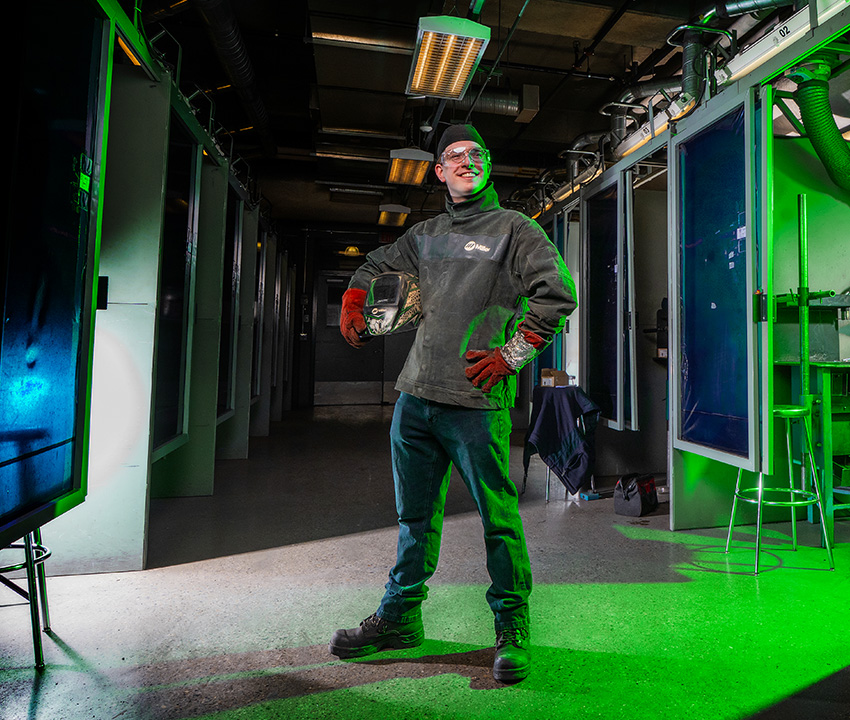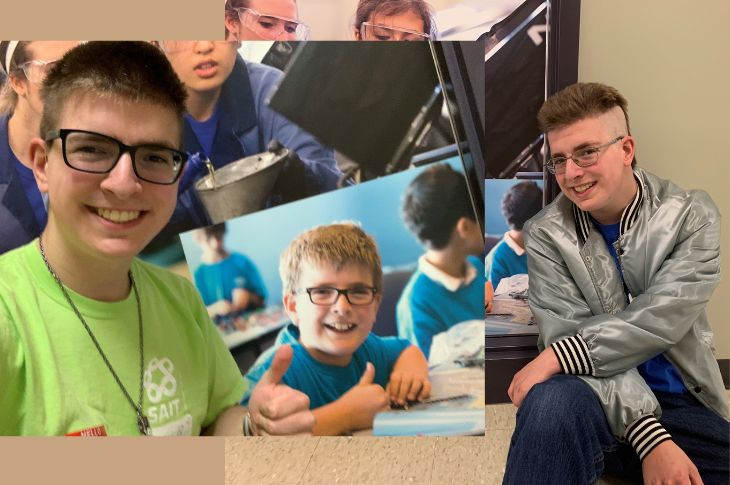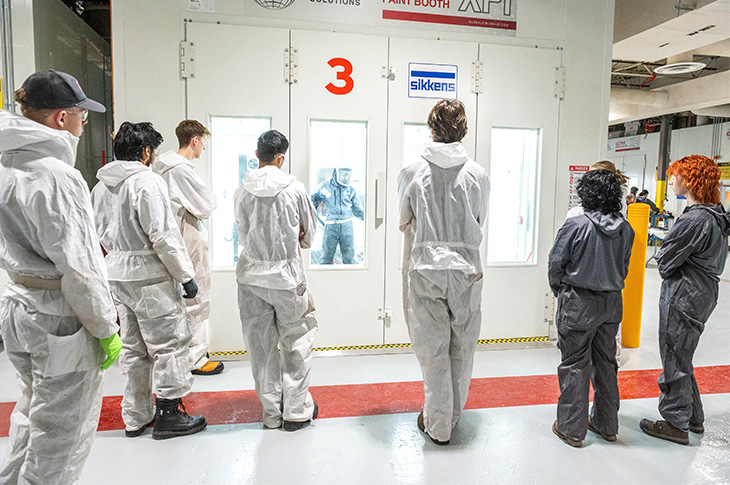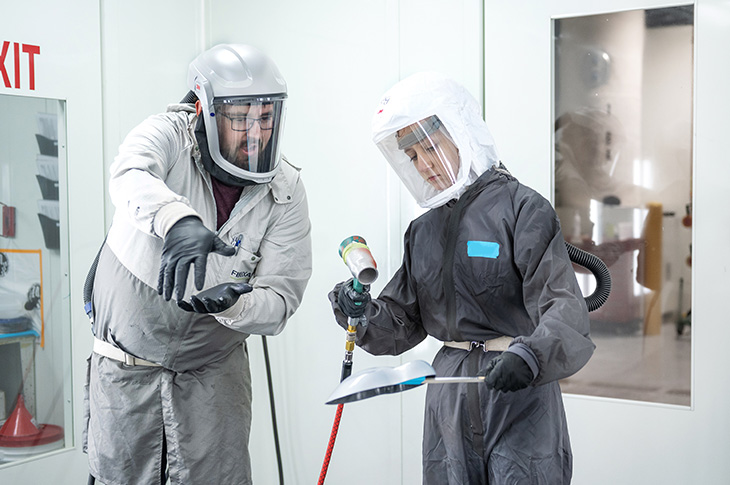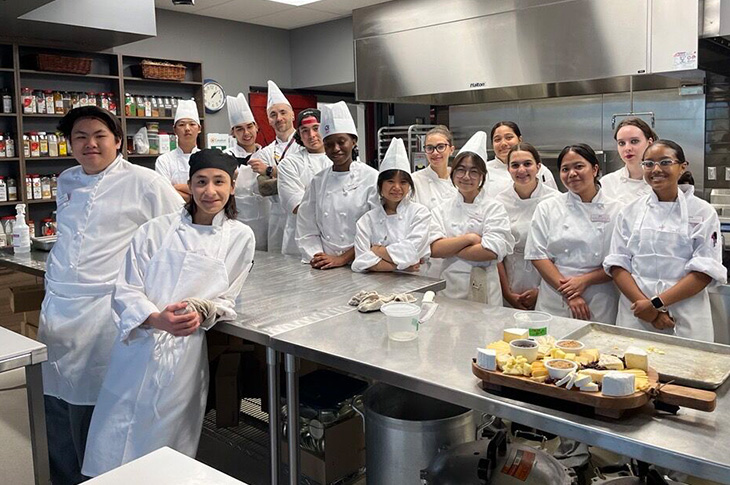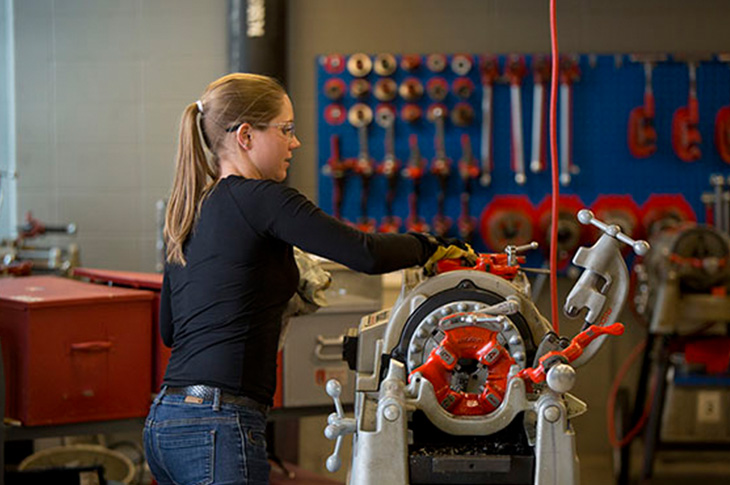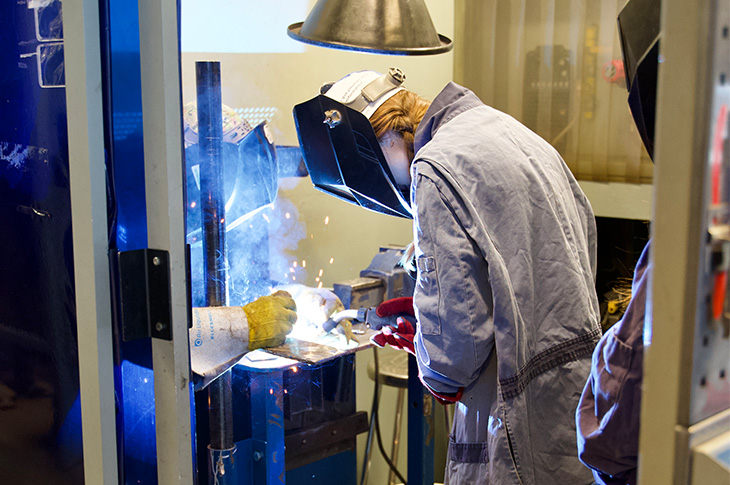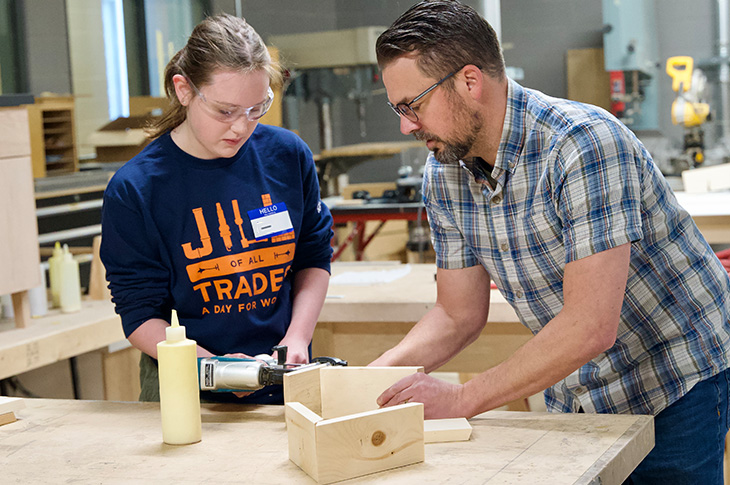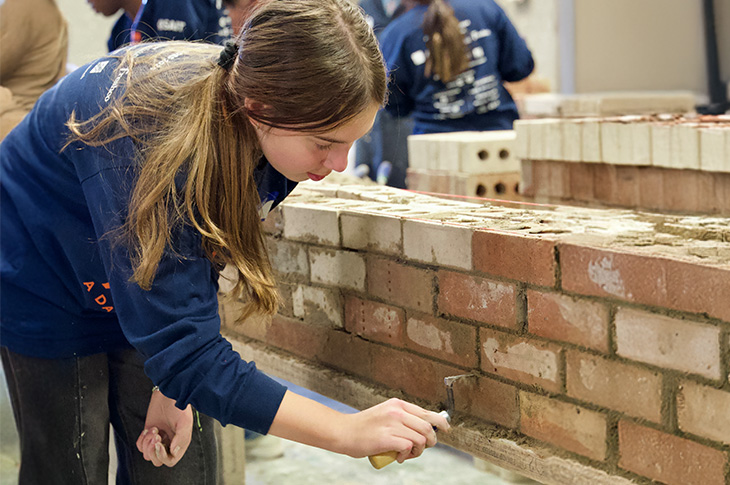First, Joey Baldes (above) was a SAIT Summer Camper, then a volunteer, then a camp leader. He was even front-and-centre in a Summer Camps marketing campaign.
Today, Baldes is a first-year Welding and Fabrication Technology student at SAIT. He’s standing beside his welding cubicle in CA209.
When nine-year-old Joey Baldes stepped out of his dad’s minivan and headed off to his first SAIT summer camp, a career as a welder was probably the furthest thing from his mind.
“I remember a few of the crafts I did, the Rube Goldberg machine I made using a mouse trap as a catapult, and a cool photo I took of sunflowers that was edited to look like a painting,” he says. “I was registered in so many summer camps between 2015 and 2022 that it’s probably shorter to list the ones I didn’t do than the ones I did. But I enjoyed the photography and science camps the most.”
After seven summers of camps, a two-month stint as a camp volunteer in 2023 and a summer as a camp leader in 2024, Baldes arrived on campus in a new role — this time as a student in SAIT’s Welding and Fabrication Technology program. “When I tried metalworking in high school, I discovered that I really liked working with my hands — it became my sanctuary. Then I started going to career fairs and realized I could make a really good living as a welder. The cherry on top? Being able to study at SAIT.”
Around the same time Baldes was disembarking from that minivan a decade ago, SAIT was starting to grow and evolve its approach to connecting more young people to successful lives and careers, says Rozlynn Wick, Associate Director of Strategic Youth Initiatives. Back then, Wick was a team of one and summer camps were SAIT’s only programs for youth. Today, she and her staff of 10 collaborate with every SAIT school and department to create and deliver dozens of camps, high school dual-credit courses, digital technology workshops and a range of other programs aligned with SAIT’s Youth Engagement Strategy — the only one of its kind in Alberta.
Designed to reach youth of different ages, interests and circumstances, the strategy focuses on four “E”s: explore, engage, experience and enter.
A student’s journey through the Es, however, isn’t necessarily linear. “We’re careful not to get stuck in a siloed approach,” explains Wick. “One step might not always lead directly to the next, but we structure all of our programs to have multiple touchpoints and opportunities for connections with each other.”
A Grade 7 student, for example, might start by exploring technology in a summer camp, then engage in one of SAIT’s digital youth workshops, move on to experience a high school dual-credit opportunity in software development, and eventually enter a program in the School for Advanced Digital Technology. Or that student might just as easily encounter SAIT in their classroom and find a different path to post-secondary education. Regardless of how they get there, one of the main objectives outlined in the Youth Engagement Strategy is helping young people and their parents feel comfortable coming to campus, getting involved and knowing their options.
“We want all youth to be excited about their education, gain a sense of belonging within the SAIT community, prepare for the future and be confident they can succeed,” Wick says. “That’s why we introduce initiatives that impact youth in meaningful ways — bringing clarity, fun and excitement, and taking away some of the more daunting aspects of the question, ‘What do you want to be when you grow up?’”
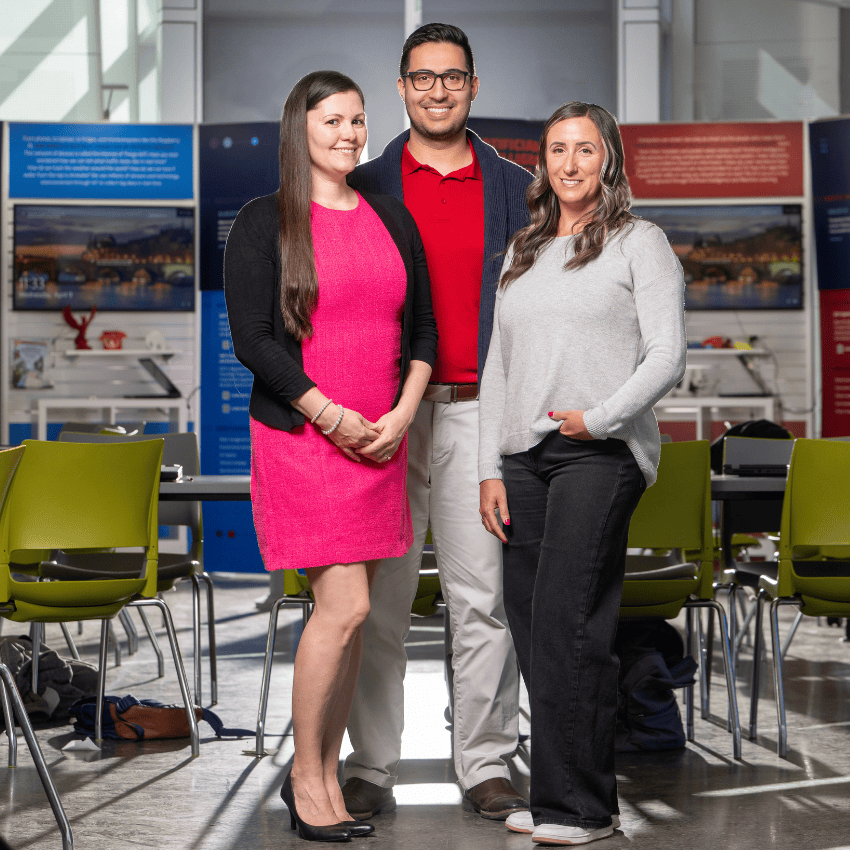
Above: “Youth Initiatives has 11 team members and our entire focus is students 18 years old and under,” says Rozlynn Wick (left), Associate Director, Strategic Youth Initiatives. Abdullah Rafih (centre) is one of three Digital Youth Program Specialists, constantly incorporating cutting-edge technologies into programs including the Digital Youth Studio. Dual Credit Coordinator Ashley Monteiro (right) leads programs aligning high-school student interest and labour market demand — all to help youth make decisions about their futures.
Explore
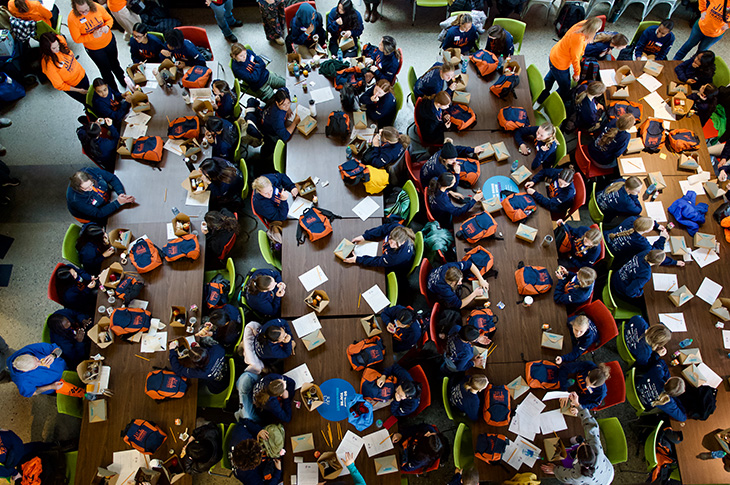
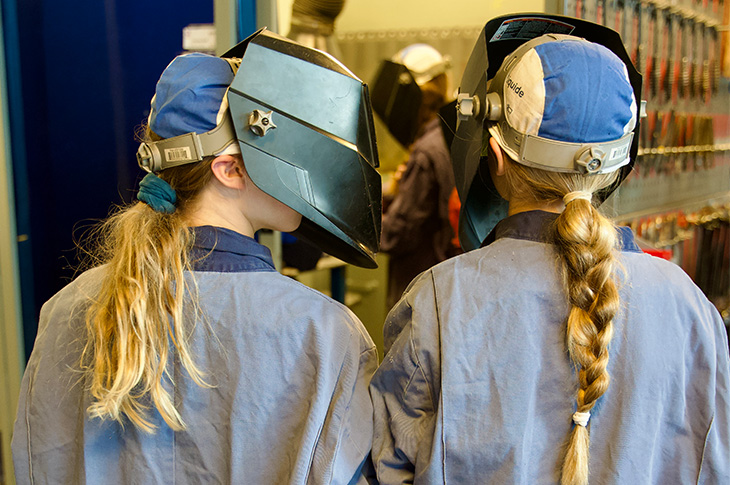
Summer camps are at the heart of SAIT’s youth engagement origin story. Since they were introduced in 2010, thousands of campers from Grades 4 to 12 have participated in weeklong programs focused on building skills and exploring a wide range of interests. This year, SAIT is offering 35 different camps — everything from Investment Masters to Healthy Kitchen Creations; from Adulting 101 to Exploring Forensics.
With dozens of camps under his belt, Baldes is a summer camp rock star, and he’s not alone.
“We see from our data that a number of students now at SAIT have taken summer camps with us in the past,” Wick says. “In addition to being fun, camps can be a first exploratory step into what we offer at SAIT.”
For the youngest campers — those going into Grade 4 — Wick says the goal is for each child to understand what activities they like and what interests them. For older campers in junior high and high school, the aim is providing a meaningful learning experience.
“If we’re doing a trade-focused camp, we’ll be in the appropriate shop, and if it’s a technology-focused camp, we’ll be in a computer lab,” Wick says. “We want to give these campers a hands-on, authentic experience that can help them see if they really love business, or technology, or STEM, or any of the other careers they are exploring over the summer.”
And today, SAIT’s youth initiatives aren’t just limited to the hottest months of the year.
"Technology is how we interact and connect with each other, so it's important for all learners to see themselves as digital citizens. Even if technology isn't the focus of whatever career they eventually choose ... they're going to be using it in every capacity of their lives."
Engage
SAIT’s vibrant Digital Youth Studio is appropriately tucked into the middle of a futuristic-looking structure in the southeast corner of the Johnson-Cobbe Energy Centre. There, Abdullah Rafih and his fellow Digital Youth Program Specialists welcome students, teachers and parents to engage with Art of the Possible workshops throughout the school year.
This series of six free digital sessions — each an hour-and-a-half long — give junior high school students an early introduction to emerging technologies, everything from artificial intelligence, machine learning and the Internet of Things (IoT) to virtual reality, augmented reality, cyber security and 3D printing and modelling.
“When students walk in, they’re amazed,” Rafih says. “It’s a living, interactive space filled with VR stations and headsets, IoT sensors, a machine learning model and 3D printers that are constantly running.”
For kids who are already interested in tech, it’s a chance to learn more about the many possibilities that exist within Calgary’s tech industry, but they’re not the only students Rafih says his team is trying to hook.
“Technology is how we interact and connect with each other, so it’s important for all learners to see themselves as digital citizens,” he says. “Even if technology isn’t the focus of whatever career they eventually choose, it’s part of the changing landscape of work and they’re going to be using it in every capacity of their lives.”
That’s also why Art of the Possible workshops take a holistic approach to emerging technology. Rafih knows the tech he’s showing off today will likely be totally different in five years or so when these students will be making choices about post-secondary education. So the workshops are less about “how to” and more about impact and applications.
“We are continually working with instructors and different teams at SAIT to incorporate new and emerging tech into workshops,” he explains. “But we also focus on rights, ethics and foundational concepts that apply no matter what technology we use.
“Equitable access is another big part of our mandate, so we offer workshops with the Mustard Seed, Black Kids Code and the Calgary Bridge Foundation for Youth,” Rafih says. “Introducing technology like a 3D printer to students who have never seen one before — that’s really empowering.”
Empowering teachers is also a focus, and it’s the inspiration behind SAIT’s new Digital Youth Technology Library. Once a teacher has brought students to Art of the Possible, they can borrow tech from the studio and bring it back to their classroom.
“We want to extend learning beyond our studio,” Rafih says. “The vision is that a Grade 9 teacher might borrow a VR headset, create an awesome lesson around it, and share that lesson with other teachers in the city so they can borrow the same tech and replicate that experience.”
"One step might not always lead directly to the next, but we structure all of our programs to have multiple touchpoints and opportunities for connections."
Experience

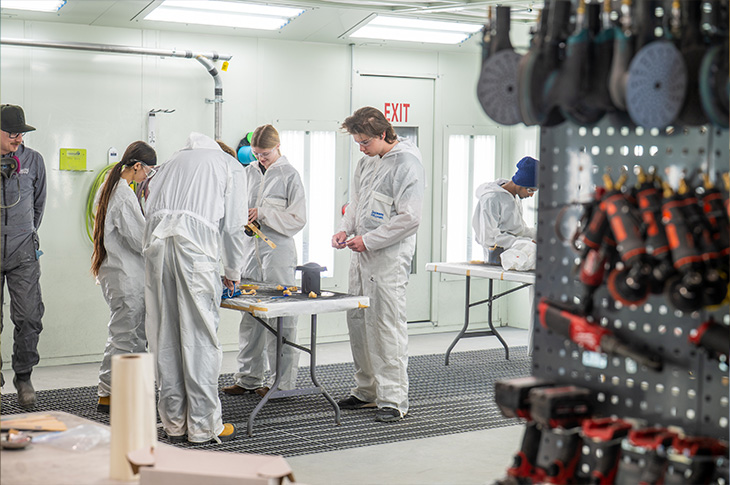
For students in Grades 10 to 12, a suite of programs called Youth Foundations offers more in-depth experiences. The Exploring Transportation Trades program brings participants directly to campus and allows them to learn foundational skills from industry-trained instructors, while the Turning Points option helps youth who face challenging circumstances develop an awareness of prospective careers as well as strategies for moving into post-secondary studies.
“These are capable kids, but they have life circumstances that are getting in the way. Some are pregnant, some face food or housing insecurity, and others don’t have a safe, secure adult in their corner,” Wick says. “Being on campus is a big deal for many of them — and that experience can have a life-changing impact on kids who never thought post-secondary education was for them. It can completely change the trajectory of their lives.”
Ayden Johnson was a 17-year-old mom, a high school student at Louise Dean School and recovering from addiction when she signed up for Turning Points.
“Being there built my confidence,” Johnson says. “I was so young, I had a baby and I had been in the trenches. I thought I would be dead by the time I was 21 — I never imagined I could be a post-secondary student.”
During the two weeks Johnson and her fellow high school students spent sampling several SAIT programs, touring the campus and learning about resources and funding opportunities, her thinking began to change.
“It opened so many doors for me,” she says. “As I started shedding the skin of my addiction and slowly shifting from this sad person into a woman who believes in herself and is independent, who can stand up for herself and set boundaries, I started to see new possibilities.”
Johnson says her own turning point was being accepted into SAIT’s Legal Assistant diploma program and receiving a bursary to pay for her education.
“Everything started lining up and I had this beautiful foundation I could build on. Now that I’m graduating, I want to work with victims and people who are at risk. I want to be a bridge to resources, to offer empathy, understanding and support.”
This year, Johnson had the chance to return to Louise Dean School and share her journey with other students. “It was surreal to think about where I've come from and that now I’m inspiring other people.”
"It is beneficial for learning what it's like to do post-secondary schooling. But the reason I appreciated this course the most was because it allowed me to work toward my high school credits at the same time that I could readily work at pursuing an interesting career."
SAIT’s partnerships with school boards are also bringing youth programming to high school classrooms across the province, often in places it has never been offered before.
“Sometimes it just isn’t feasible for students to come to the SAIT campus for our programs,” says Dual Credit Coordinator Ashley Monteiro. “That’s why we don’t have a singular program delivery model. Instead, we try to be a good collaborative partner and find a way to make things work. More often than not, we can find a creative solution.”
One example is a dual-credit culinary program with Mînî Thnî (formerly Morley) Community High School. Over two semesters, Mînî Thnî’s food program teacher, Jamie Martin, teams up with SAIT instructors who are Red Seal-certified chefs and bakers to teach students working towards six SAIT post-secondary credits and ten high school credits.
“Jamie has been a huge part of making this model work,” Monteiro says. “We have the same goal in mind — helping students see pathways and options they may not have considered before.”
Grade 12 Mînî Thnî student Alaya Hunter was in as soon as she heard about the program.
“My late cousin attended SAIT a few years back, and I got inspired by him to become a chef. But I did not think I was going to succeed,” she says. “When I joined this program, I got the motivation again. Getting to know the chefs that came from SAIT and getting to learn actual chef skills from them was what I enjoyed most.”
Hunter and her classmates got to meet even more SAIT chefs when they made the trip to campus to explore the School of Hospitality and Tourism and its teaching kitchens. “It’s always an exciting day,” says Monteiro. “On-campus experiences can help students see their futures in a new way.”
550+ youth from deserving populations, including Indigenous youth and youth who are newcomers, participated in SAIT Youth Programs during the 2023/24 academic year.
Monteiro says that even if students decide not to pursue a culinary career, they walk away with life skills they can use throughout their lives. But for some students, including Hunter, the experience has the potential to be career-defining.
“My experience was honestly the best and made me actually want to attend SAIT after high school,” says Hunter. “I’m not really sure how I’m supposed to feel about choosing this path. I just want to succeed and, to be honest, I feel so happy.”
Back at Mînî Thnî, when the food program classes start to wrap up, the whole community gets in on the action. Typically, at the end of the program, the students put on a spread and invite members of the community to see what they have accomplished.
“When I attended the community celebration at the end of the baking course in the Fall semester, I saw students who were proud to showcase the skills they have learned,” says Monteiro. “It was so meaningful to see them share their knowledge and creations with their community in a very tangible way.”
550+ youth from deserving populations, including Indigenous youth and youth who are newcomers, participated in SAIT Youth Programs during the 2023/24 academic year.
Enter
Joshua and Benjamin Fray have always loved tinkering. As little kids, the twin brothers were constantly taking things apart and putting them back together. So, when it came time to start thinking about their careers, the trades just made sense, Joshua says.
In Grade 11, he was scrolling through SAIT’s dual-credit offerings, researching training in refrigeration and air conditioning, when he happened to see the Recreation Vehicle Service Technician apprenticeship program. The two brothers were intrigued.
“It was really appealing to take a broad look at the various different skills — construction, siding, roofing, plumbing, electrical and more,” Benjamin says. “RV tech has a lot of the skill sets we like to learn about and use.”
After some more research, the pair signed up for SAIT’s Dual-Credit Pre-Employment RV Technician program, which is unique in Alberta.
At the end of the school year, they were both hired by the largest RV dealer in Canada and spent the summer of 2024 inspecting new RV units, providing service and even making the occasional trip out to a campsite for a mobile service call. Last fall, they headed back to SAIT for eight weeks of classroom instruction towards their second period of apprenticeship.
Today, they’re back at Traveland RV, building up their hours and getting ready to return for another round of classroom instruction.
While Joshua enjoys the plumbing aspect of his trade the most, Benjamin loves the problem-solving that comes with electrical issues. They're both excited about the future.
“This is a trade that offers something different every day,” says Benjamin. “And we have an even greater goal of travelling and volunteering with our church and using our skills in that way.”
Seeing young people from all walks of life find their confidence, set their goals and head down a path where they can be successful is one of the best parts of the job for SAIT’s Youth Initiatives team.
“We’re grateful to the Calgary Board of Education, the Calgary Catholic School District, Fusion Collegiate, and the many other urban, rural and Indigenous school authorities across Alberta who partner with us,” Wick says. “We’re also grateful for our industry partners who so willingly support pathways for our youth.
“It’s incredibly rewarding to know we’re playing some small part in helping young people make decisions that will affect them for the rest of their lives.”
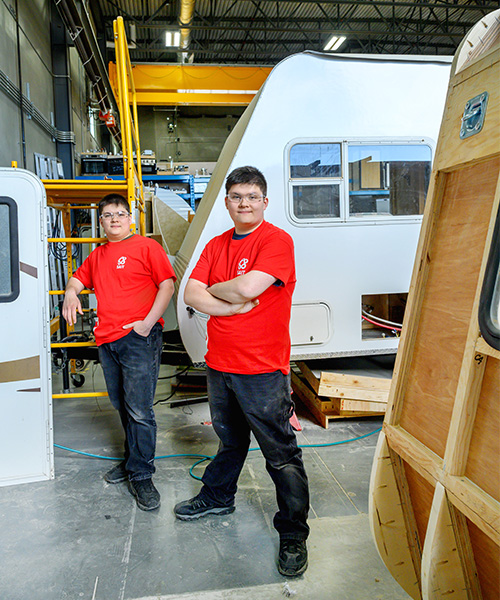
Above: As part of SAIT’s Dual-Credit Pre-Employment RV Technician program, students put theory into practice by rebuilding the plumbing and electrical systems in this full-size trailer. Twin brothers Benjamin (left) and Joshua Fray have completed the program but returned to the RV shop at the Point Trotter Campus for this photo shoot.
A peek at the programs
It's one thing to hear about the many different SAIT programs available for youth — from camps to workshops to events to dual credit — but it's another to see them in actions. Flip through the photos to get a taste of what students 18 years old and under get to experience first-hand.

Like what you are reading?
Find more stories from past, present and upcoming issues of LINK magazine!
Oki, Âba wathtech, Danit'ada, Tawnshi, Hello.
SAIT is located on the traditional territories of the Niitsitapi (Blackfoot) and the people of Treaty 7 which includes the Siksika, the Piikani, the Kainai, the Tsuut’ina and the Îyârhe Nakoda of Bearspaw, Chiniki and Goodstoney.
We are situated in an area the Blackfoot tribes traditionally called Moh’kinsstis, where the Bow River meets the Elbow River. We now call it the city of Calgary, which is also home to the Métis Nation of Alberta.
